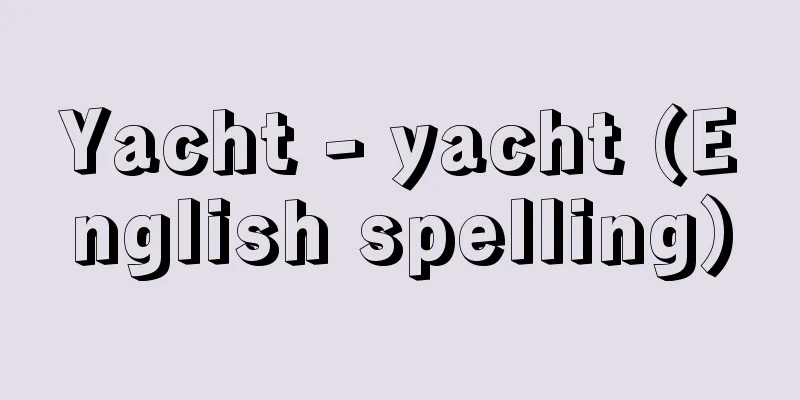Yacht - yacht (English spelling)

|
A general term for boats used for travel, cruising, and sports on rivers, lakes, and oceans. Also called pleasure boats. They are graceful, comfortable, and light, and can withstand waves. There are engine-propelled yachts and sailing yachts equipped with sails when cruising. Depending on the type of engine, engine-propelled yachts are classified as steam yachts and motor yachts, but motor yachts are the norm, except for large ships and special ships. Most large yachts for cruising, complete with living facilities, owned by countries, royal families, and wealthy people in Europe and America, such as the British Royal HMS Britannia, are engine-propelled and not equipped with sails. In the narrow sense, sailing yachts equipped with sails are often called yachts. [Satoshi Iwai] historyIn the early 17th century, a fast sailing ship called a jaght appeared in the Netherlands. This ship had a vertical sail along the bow-stern line, and a board called a leeboard was hung from the side of the ship to prevent the ship from drifting sideways to the leeward side. It had excellent sailing performance and good maneuverability, being able to sail at a course of about 6 points (67 degrees 30 minutes, one point is 360 degrees 32 minutes) against the wind direction, and was used for chasing pirates, connecting large ships at anchor, and communicating with land. Eventually, jaghts came to be used for sports and sightseeing, such as speed competitions and enjoying sailing. In 1660, when Charles II, who had been in exile in the Netherlands, took the throne after the restoration of the British monarchy, a jaght was presented to him as a gift. In England, jaghts were called yachts, and they became popular among the upper class for sea sports such as racing and sightseeing (cruising), and as the hulls became smaller, they quickly became popular among the general public. Yacht racing has become internationalized across the ocean, and cruising is expanding to the seven seas. [Satoshi Iwai] Rigging styleThere are many different ways to rig sails on a yacht. (1) Cat: A relatively large sail is hung on a single mast close to the bow. It is easy to maneuver and can achieve considerable speed, so it is also used for small racing boats. Dinghies such as the Finn and Laser are of this style. (2) Sloop A sloop is a boat equipped with one sail at the front and one at the rear of a single mast. It is the most common style of boat, being light and maneuverable, and used on calm waters. The FJ, Snipe, Seahorse, 470, Star, and Soling belong to this type. (3) Cutter: Emphasis is placed on seaworthiness as well as speed. The boat has a deep draft and is heavy. The rigging style is similar to that of a sloop, but has two or more sails forward of the mast. (4) Yawl: A yacht with two masts and a sail on the rear mast for improved maneuverability. It is a large boat and is suitable for sailing in rough ocean waters. (5) Ketch: An improved style of yawl, with the stern mast moved slightly forward, a larger rear sail, and two sails forward of the front mast to improve sailing performance. (6) Schooner: A schooner with a tall mast at the rear and a sail at the front. Larger schooners can have three or more masts. It combines the advantages of a yawl and a ketch, and is excellent in propulsion, maneuverability, and control, making it a type of vessel that meets the requirements for cruising. [Satoshi Iwai, Katsumi Shibanuma] Sail PropulsionSailing yachts move with propulsion generated by the wind acting on the sails. When the wind hits the sails at an angle, the wind flows along the curve of the sail, tracing a streamline. At this time, air pressure increases on the windward side of the sail, creating a pressurized force (pressurized area), while pressure decreases on the leeward side, creating a suction force (depressurized area), generating a force (resulting force) that pushes the sail downwind. The component of this resultant force toward the bow becomes the propulsive force that pushes the boat forward. The lateral component of this force becomes a lateral drift force that pushes the boat downwind. It is necessary to keep the lateral drift of the boat as small as possible, so the boat is equipped with a centerboard, etc. to increase the water pressure resistance that counters the lateral movement of the boat. When the sails are stretched out to the side and the wind is coming from the stern, the force acting on the sails is in the same direction as the forward movement of the boat, generating a propulsive force proportional to the force applied. It is considered desirable to design and operate (sail) the sails and boat in such a way that the propulsive force from the sails is maximized. [Satoshi Iwai] Types of sailing and steeringSailing can be broadly divided into three types depending on the wind direction relative to the boat and the way the sails are set. Also, when the boat receives the wind from the starboard side, it is called a starboard tack, and when the boat receives the wind from the port side, it is called a port tack. [1] Close-hauled Sailing with the bow fully upwind. Sailing against the wind while taking a course as close as possible to the wind. This is called being close to the wind or fully upwind. This is a sailing technique used when sailing upwind while taking a zigzag course, alternating between starboard and port against the wind (this is called "beating"). The boat's course against the wind can be turned up to about 35 to 45 degrees depending on the sails and the boat's performance. However, turning the bow upwind too much reduces the flow of air around the sails, causing the sails to flap and ripple (shiver), resulting in a loss of speed. Also, if the bow of the boat drops too far downwind (points the bow too far downwind), a sudden large wind pressure acts on the sails, which can increase sideways drift and cause a sudden large list to the leeward side. When sailing close-hauled, it is important to maintain a stable course against the wind. There are two methods of turning a boat, which changes direction from left to right and right to left in order to zigzag upwind. (1) Tacking is a maneuver in which the bow of the boat is turned into the wind to change the side that receives the wind. Tacking is likely to fail if the boat does not have enough speed, so it is necessary to accelerate sufficiently and use the rudder and sails to turn the boat in one go. (2) Wearing is a method of turning the boat by lowering the bow to the leeward side, so there is no loss of speed and it is easy to turn even when the wind is weak. However, when the boat continues to turn and the wind direction becomes directly behind it and the sails are changed (gybing), a large wind pressure acts on the sails in an instant, which can be dangerous, so great care must be taken when operating the boat. [2] Running A sailing technique in which the boat catches the wind from the stern, stretches out the sails almost directly to the side, and is pushed forward by the wind downwind. Since the sail on the bow side (headsail, jib sail, jib) is shaded by the sail behind (mainsail, mensail) and cannot catch the wind sufficiently, whisker poles (thin cylindrical materials) are used to stretch the sails outboard of the boat on the opposite side to the mainsail, so that the sails can catch the wind to the fullest. The two sails are stretched out on both sides, so they are called Kannon-bira (open-back sails). To increase propulsion and stability when sailing or reaching, as described below, a thin, colorful, triangular sail called a spinnaker sail may be stretched. When sailing, the part of the sail that extends outboard becomes wider, so the center of wind action moves away from the center line of the boat to the side, generating a turning moment. In addition, the wind flow around the sails, especially the reverse current, becomes less stable, and the boat is rocked by following waves. This makes it difficult to maintain course and makes steering difficult. As mentioned in the section on changing direction by wearing close-hauled, gybing, which involves changing the side of the boat that is receiving the wind while running, involves the risk of being suddenly subjected to a large amount of wind pressure, so it is important to be very careful when maintaining course and maneuvering the sails. In addition, because course stability is poor when running, the crew should move as far aft as possible and take measures to increase the trim (the fore-aft tilt of the boat) toward the aft. [3] Leeching: This refers to a state of sailing between close-hauled and running, with the wind at 45 to 180 degrees to the bow. When the wind is directly across the boat, it is called a beam reach, when the wind is closer to the bow than that, it is called a close reach, and when the wind is directly across the boat and closer to the stern, it is called a broad reach. In either case, it is necessary to decide the boat's course and carefully adjust the direction of the sails little by little to sail carefully. [Satoshi Iwai, Katsumi Shibanuma] [References] | | | |©Shogakukan "> Yacht rigging style ©Shogakukan "> Propulsion by sails on a yacht ©Shogakukan "> Types of yacht sailing ©Shogakukan "> How to sail a yacht ©Shogakukan "> Yacht section names (470 class) ©Shogakukan "> Yacht board and keel Source: Shogakukan Encyclopedia Nipponica About Encyclopedia Nipponica Information | Legend |
|
川や湖、海洋での回遊や巡航、スポーツなどに使用される船艇の総称。快遊船ともいう。優美で乗り心地がよく、軽快さが特徴で、波に対しても耐える性能を備えている。機関によって推進巡航するものと、帆(セールsail)を備えて巡航時には帆走(セーリング)するものとがある。機走するヨットは機関の種類によって蒸気ヨットとモーター・ヨットがあるが、大型船や特殊な船を除いてはモーター・ヨットが一般的である。イギリス王室のブリタニア号などヨーロッパやアメリカで国や王室、富豪などが所有する居住施設の完備した巡航用の大型ヨットは、ほとんどが機走で帆を装備していない。狭い意味では帆を備えたセーリング・ヨットをヨットとよぶことが多い。 [岩井 聰] 歴史17世紀の初めにオランダでヤハトjaghtという快速帆船が現れた。この船は船首尾線方向に沿って鉛直に縦帆を張り、リーボードという板を船側から垂らして、船が風下側に横流れするのを防いでいた。帆走性能も優れ、風向きに対して6点(67度30分。1点は32分の360度)程度までの針路を保って帆走できる良好な操縦性を備えており、海賊の追跡や、停泊中の大型の船と船、あるいは陸との連絡に使用された。やがてヤハトどうしでスピードを競ったり、帆走を楽しむなどスポーツ用、遊覧用にも用いられるようになった。1660年、イギリスの王政復古によって、オランダに亡命していたチャールズ2世が王位についた祝いに、1隻のヤハトが贈られた。ヤハトはイギリスでヨットとよばれ、レーシングなどの海上スポーツや遊覧(クルージング)用として上流社会に普及し、さらに船体の小型化とともに急速に一般に普及した。ヨットレースは大洋を舞台に国際化し、クルージングも七つの海へと広がりをみせている。 [岩井 聰] 帆装様式ヨットにはいろいろな帆の張り方(リグrig)がある。 (1)キャット cat 艇首に近い1本マストに比較的大きな帆を張る。操縦が簡単でかなりの速力が出るので、小型のレース艇にも使われている。フィン、レーザーなどのディンギーはこの様式である。 (2)スループ sloop 1本のマストの前と後ろに各1枚の帆を装備する。操縦性がよく軽快で、波の少ない水面で用いられるもっとも一般的な様式である。FJ、スナイプ、シーホース、470、スター、ソリングなどはこのタイプに属する。 (3)カッター cutter 速力だけでなく耐航性も重視している。喫水が深く艇も重い。帆装様式はスループに似ているが、マストの前方には2枚以上の帆を備える。 (4)ヨール yawl 2本マストを備え、後部マストの帆によって操縦性を向上させた。艇を大きくし、外洋の波浪中での帆走に適するヨットである。 (5)ケッチ ketch ヨールを改良した様式で、艇尾のマストをやや前方に移して後帆を大きくし、前のマスト前方の帆を2枚装備するなどして帆走性能を向上させている。 (6)スクーナー schooner 後ろのマストを高くしてその前側にも帆を備えている。大型では3本、またはそれ以上のマストを装備するものもある。ヨールやケッチの長所を取り入れ、推進性、操縦性、操作性などが優れ、巡航用としての条件を満たす様式である。 [岩井 聰・柴沼克己] 帆による推進力セーリング・ヨットは帆に働く風によって推進力を得て航走する。帆に斜め方向から風が当たると、風は帆のカーブに沿って流線を描きながら流れる。このとき、帆の風上側では空気の圧力が増して加圧力を生じ(加圧域)、風下側では圧力が減じて吸引力が生じ(減圧域)、帆を風下側へ押す力(合力)を発生させる。この合力の艇首方向への分力が艇を前進方向に押す推進力となる。横方向への分力は艇を風下側へ押す横漂流力となる。艇の横漂流は極力小さく抑えることが必要なので、艇の横移動に対抗する水圧抵抗を増すようにセンターボードなどが装備されている。 帆を真横に張り風を艇尾から受ける場合は、帆に働く力の方向が前進方向と一致し、加圧力に比例した推進力を生じる。セーリング・ヨットは、この帆による推進力がより大きくなるように、帆と艇を設計し、操縦(帆走)することが望ましいとされる。 [岩井 聰] 帆走の種類と操縦帆走は艇に対する風向きと帆の張り方で次の三つの形式に大別される。また、風を右舷(うげん/みぎげん)側から受ける場合をスターボードタックstarboard tack(右舷開き)、左舷側(さげん/ひだりげん)から受ける場合をポートタックport tack(左舷開き)という。 〔1〕クロースホールド close-hauled 艇首を風上にいっぱいに寄せた(風上にいっぱい切り上げるという)姿勢で帆走する状態をいう。風上に向かって近づきうるぎりぎりの針路をとりながら風に逆らって航走する。詰(つめ)開き、あるいは一杯開きという。風向きに対し右舷開き、左舷開きを交互に繰り返してジグザグ針路をとりながら風上方向に航走する(このことを「間切(まぎ)る」「ビーティング」という)場合に用いる帆走法である。風に対する艇の針路は、帆や艇の性能によって35度から45度程度まで切り上げることができる。しかし、艇首を風上に切り上げすぎると、帆の周りの風の流れが悪くなり、帆がばたばたと波打って(シバー)速力が落ちてしまう。また、艇首が風下に落ちすぎると(艇首を風下に向けすぎると)、急に大きな風圧が帆に働き、横流れの増大や風下側への突然の大きな傾斜をおこす危険がある。クロースホールドの場合は風に対して安定した針路の保持がたいせつである。 風上に向けてジグザグ針路をとって進むために、風を受ける舷を左から右、右から左と変える艇の操縦には、2種類の方向変換の方式がある。 (1)タッキングtacking(上手(うわて)回し)は艇首を風上に向けて風を受ける舷を変える操法である。行き足(艇の速力)が不足すると失敗しやすいので、十分に加速して舵(かじ)と帆を使い一気に回頭させなければならない。 (2)ウェアリングwearing(下手(したて)回し)は艇首を風下側に落としながら回頭するので速力も落ちず、風が弱いときでも回頭しやすい方法である。しかし、回頭が進み風向きが真後ろになって帆の舷を変える(ジャイビング)とき、瞬間的に帆に大きな風圧が働いて危険な場合があるので、操作には十分な注意を要する。 〔2〕ランニング running 艇尾から風を受け、帆をほぼ真横方向に張り出して風に押されて風下に前進してゆく帆走法である。風を真後ろから受けるために艇首側の帆(ヘッドセール、ジブセール、ジブ)は後ろの帆(メインセール、メンスル)の陰になって十分に風を受けられないので、ウィスカーポール(細い円柱材)でメインセールと反対舷の舷外に展張し、風がいっぱいに当たるようにする。2枚のセールを両舷に開いて張るため観音(かんのん)開きとよぶ。ランニングや次に述べるリーチングで帆走する場合に推進性や安定性を高めるため、スピネーカーセールという色とりどりの三角形の薄い帆を張ることもある。ランニングでは帆の艇外に出る部分が広くなるので、風の作用中心が艇の中央首尾線から離れて舷側に移り、回頭モーメントを生じる。また、帆の周りの風の流れ、とくに反流の安定性が悪くなり、さらに追い波による艇体の動揺が加わる。したがって、針路の保持が困難になり操縦しにくい。クロースホールドのウェアリングによる方向変換で述べたように、ランニングの状態のまま風を受ける舷を変えるジャイビングは急に大きな風圧を受ける危険を伴うので、針路の保持や帆の操作には十分な注意が肝要である。なお、ランニングの場合は針路の安定性が劣るので、艇員はできるだけ艇尾に位置を変え、トリム(艇の前後の傾き)を艇尾側に増大させる措置も必要である。 〔3〕リーチング leeching クロースホールドとランニングの中間、艇首に対して45度から180度程度までの風を受けて帆走する状態をいう。真横の風を受ける場合をビームリーチ、それより艇首寄りの風を受ける場合をクロースリーチ、艇の真横から艇尾寄りの風を受ける場合をブロードリーチとよんで区分する。いずれの場合も艇の針路目標を決め、帆の向きを少しずつていねいに調整し慎重に帆走する必要がある。 [岩井 聰・柴沼克己] [参照項目] | | | |©Shogakukan"> ヨットの帆装様式 ©Shogakukan"> ヨットの帆による推進力 ©Shogakukan"> ヨットの帆走の種類 ©Shogakukan"> ヨットの操縦法 ©Shogakukan"> ヨットの各部名称(470級) ©Shogakukan"> ヨットのボードとキール 出典 小学館 日本大百科全書(ニッポニカ)日本大百科全書(ニッポニカ)について 情報 | 凡例 |
<<: Four-toothed crab (Pugettia quadridens)
>>: Four-handed net - Yotsudeami
Recommend
Monroe, B. (English spelling) MonroeB
...It is characterized by the use of five-string ...
IBF (Aviation) (English spelling)
...However, for medium to large aircraft, if the ...
Czerny, A.
...Nutrition metabolism is then disturbed, result...
Osteospermum genus
...The genus Di (two) morphe (shape) theca (wrap)...
Jumna
…A tributary of the Ganges River that flows down ...
Information
...As already mentioned, these concepts were only...
Gastric digestion - Inaishouka
…Since α-amylase does not act on α-1,6 glucosidic...
White-eye flower - White-eye flower
A perennial herb of the Ranunculaceae family (illu...
Yaeyama scorpion (Liocheles australasiae)
An arthropod (illustration) of the family Scarabae...
The island of the unspoken
...Even in everyday life, people say "atarim...
Kart
…the native government of Afghanistan under Mongo...
Genet - Genet (English spelling)
In the broad sense, it is a general term for anim...
Dionysius Exiguus (English spelling)
…This is the calendar system that counts the year...
Bell tower - Shoro
A building for hanging a bell and ringing it. It ...
hyang yak (English spelling)
…At the beginning of the Qing Dynasty, the Ming D...









